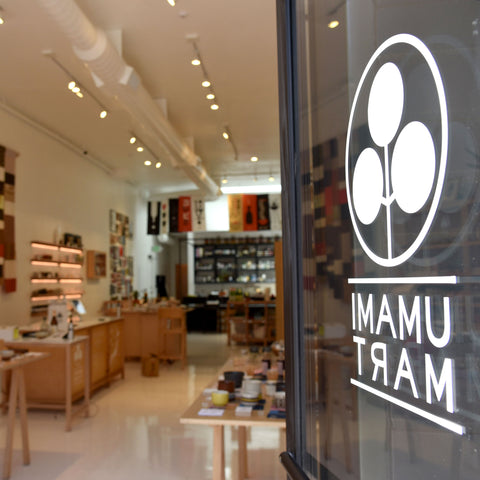 President Toshimitsu Saika of Kokonoe Saika
President Toshimitsu Saika of Kokonoe Saika
All members of Sake Gumi this month are getting Kokonoe Saika Sake Brewery’s Yamada Nishiki Junmai Daiginjo. Toshimitsu Saika, the president of Kokonoe Shuzo visited us back in 2023, and he took the time to answer some of my questions below. Their unique history, as a brewery that started out making vinegar, is closely tied to the fact that Wakayama is said to be the birthplace of sushi. Kokonoe Saika is well known for the akazu, or red vinegar, which is brewed with sake lees, which we are now carrying in the store.
Umami Mart: What does Kokonoe Saika mean?
Toshimitsu Saika: In the east, nine is the largest odd number, so we named our company Kokonoe, or nine-fold. Nine is an auspicious number and we hope to fold and overlap auspicious events into eternity. Saika is our family name and gives us a sense of mission.
Our mission is to “contribute to deliciousness around the world by transcending the boundaries of food culture.” To carry out this mission, we were Kosher certified in 2021, Halal and vegan certified in 2023. We were also a part of the 2023 Sustainable Development Goals (SDGs) Action Declaration, which looks toward ending poverty, protecting the planet, and leaving no one behind.
 Steamed rice at the brewery
Steamed rice at the brewery
I like the idea of thinking of sake as an inclusive beverage. It reminds me of my experience when I visited Wakayama last year. People were very kind and thinking about the future of the environment. What can you tell me about the landscape of Wakayama?
Wakayama Prefecture has long been known as a sacred place for nature worship. The Kumano Kodo (Pilgrimage Route), Kumano Sanzan are World Heritage Sites that connected to the gods of nature.
The Kumano faith is based on the ancient worship of nature, and the style of faith that purifies and regenerates the body and mind by walking on steep mountain roads and pilgrimage routes. The practice of visiting various natural places such as the sun, the sea, forests, waterfalls, rocks, and rivers is still very much alive today. Since ancient times, this faith has accepted all people regardless of purity, social status, race, or religion, so not only the common people but also the retired emperors of the time frequently visited the shrine.
The Kumano Pilgrimage Route has a sister road partnership with Spain's "Road to Santiago." For this reason, many people from overseas now come to walk along this path, making it a world-class sacred tourist destination (sacred resort) that is especially popular with Westerners.
Wakayama is also the birthplace of seasonings and dishes including sushi, soy sauce, wasabi, sansho pepper, bonito flakes, Kinzanji miso, and Koya tofu. It is a place that has historically contributed to Japanese food culture since ancient times.
I didn’t know what sushi originated in Wakayama. How does your brewery fit into this history?
We make akazu, which is ideal for making sushi rice. We are the only brewery that makes both akazu vinegar and sake. In fact, we started as a vinegar maker in 1908, but realized that to make the best vinegar we needed a consistent supply of sake lees. That is why we started making sake in 1934.
I love the three-legged crow on the label. What is the yatagarasu legend?
Yatagarasu means large crow and is said to be a messenger of guidance. Since ancient times, the yatagarasu is depicted as a legendary three-legged crow that is said to have swooped down to prevent Emperor Jinmu from getting lost when he made a pilgrimage to Kumano.

I feel like I’ve seen this crow other places.
That’s right, Yatagarasu emblems are used with people associated with the Kumano Sanzan, the Shiga clan, and the Japan Football Association. The Japan Football Association uses yatagarasu as their symbol because the birds are known to ‘guide you to victory.' I've heard that the "Yatagarasu" myth exists not only in Japan, but also in China, Korea, and Spain. Yatagarasu is popular all over the world due to its connection to sun worship and the legend of ravens.
Can you tell me a little bit more about the evolution of Kokonoe Saika, after the production of sake?
The founder, my great-grandfather Toyokichi Higa, started producing sake in 1934 with two ideas, 1) to make better vinegar, we should make it from sake lees and 2) create sake that goes well with meals.
We continue our commitment to make sake that goes well with sushi for many years. With the support of the Taste and Aroma Strategy Research Institute, we have scientifically analyzed and quantified the matching of shari (vinegared rice), neta (seafood typical of sushi such as tuna and shrimp), soy sauce, and various types of sake. We continue to research the optimal marriage and utilize this in designing the taste of sake.
 Koji production at Kokonoe Saika
Koji production at Kokonoe Saika
What is one thing you’d like to tell someone who is thinking of visiting Wakayama?Since Wakayama is the birthplace of sushi, there are many different types of sushi to try here, not only Edomae. I invite you to try narezushi and hayazushi, which are the origins of sushi. Get further into Wakayama sushi specialties including: jyako, saury, mehari, and wasabi.
I feel like jumping out of my seat and booking my next trip to Wakayama! Thank you so much for your time and we’ll all celebrate Wakayama this month by having a sushi dinner with your Junmai Daiginjo. Kanpai!




Comments (0)
There are no comments for this article. Be the first one to leave a message!